Your browser does not fully support modern features. Please upgrade for a smoother experience.
Please note this is an old version of this entry, which may differ significantly from the current revision.
Subjects:
Forestry
Daegwallyeong is a mountain pass at an altitude of 832 m, which has been designated a conservation area because of its essential role in Korea’s forest ecosystem. Simultaneously, this area is considered a suitable place for forest grazing due to the cool temperature during the summer.
- Daegwallyeong
- rare plant
- livestock feeding
- vegetation
- disturbance
1. Introduction
As about 63% of Korea’s total land area is made up of forests, timber production has been traditionally regarded as the primary role of forestry and has accounted for most forestry [1][2]. However, forests in Korea’s mountainous regions are not accessible for traditional timber production, and the types of forests vary from region to region [3]. Woody plants for timber production have a very long growing period and a low return on capital until harvest; as such, forest households needed a new form of forestry [4]. In some forests, agricultural technology was applied to produce short-term income crops in parallel [5]. Moreover, introducing economic benefits to forest grazing is a complex land-use form that combines grazing in the forest with ecological livestock technology [1][6]. However, with the emergence of goals related to preservation of the natural environment and conduction of environmentally friendly development, the number of grassland creations has declined. Within these concepts, sustainable development, which enables economic activities while minimizing environmental damage, has become comprehensive. As a result, forest grazing, a combination of forestry and agriculture (mainly livestock), tends to be activated without assessing the natural environment’s impacts.
In the concept of forest grazing, Daegwallyeong was a good candidate due to its environmental conditions and location. Because Daegwallyeong is located at a high altitude, there are fewer diseases than at low altitudes, resulting in favorable conditions for raising livestock. In the 1970s, the government of South Korea provided financial support for pastoral farming, and some forests with similar conditions were converted to pasture, including Daegwallyeong high hills. Since then, there has been conflict between the two groups advocating for conservation versus development of the forest areas for forest grazing, especially at this location. Because it is an important area with high biodiversity, representing the core ecological axis of Baekdu-daegan [7], the Ramsar Wetlands in the high mountains of Mt. Odae has been designated as having unique and diverse biota and landscape characteristics [8]. By converting the abandoned forest area to pasture, some positive effects were observed in the deforested land. However, forest grazing may indeed harm the natural forest ecosystem. Therefore, an improved livestock method should be pursued in depth to develop rational and scientific alternatives to current forest grazing [9]. However, the livestock industry is focused on improving animal welfare rather than minimizing loss of biodiversity. The flora biodiversity can be more negatively affected, and these effects may be irreversible once it disappears from the natural habitats. Therefore, the flora changes should be monitored in previously established pastures to minimize harm. In particular, before grasslands in the forest are formed, the natural forest ecosystem must be identified, and problems that may arise due to grassland formation must be predicted and avoided [10].
2. Total Number of Vascular Plant Species in the Study Sites over Time
The numbers of plant taxa at each classification level in the year 2014, i.e., original composition without any forest management practices, in 2015, 2016, and 2017, when disturbed by heavy thinning and residue removal on the forest floor, and in the year after grazing (2019) are summarized in Table 1. The numbers and compositions of plants were slightly different across each year. There were 92 families, 257 genera, 311 species, eight forms, three subspecies, 44 varieties, and 366 taxa of vascular plants in the study sites in 2014 at the time of the survey beginning, prior to any disturbance. We found changes in the flora composition after each event. At first, varieties of plant species were changed after the thinning and residue removal in 2015. The total number of taxa was decreased to 360, comprising 92 families, 254 genera, 309 species, six forms, three subspecies, and 42 varieties in 2015. At this time, nine taxa appeared, but 16 disappeared. Newly emerged plants belonged to Compositae and Lilaceae, whereas three taxa of Polygonaceae were not found in 2015. More plant taxa, 366 taxa in total, were found with 93 families, 257 genera, 312 species, seven forms, three subspecies, and 44 varieties in 2016, a year after thinning and short grazing practices. In 2017, however, fewer families, 89, were found, with 243 genera, 288 species, seven forms, three subspecies, 44 varieties, and 342 taxa in total. While 31 plant species disappeared, only a few plant species returned at this time. When we performed a plant survey in 2019, a year after no feeding, the total number of plant taxa was 357, including 89 families, 249 genera, 300 species, three subspecies, 47 varieties, and seven forms. This number was increased from 2017 but decreased compared with 2014, 2015, and 2016. When the plant taxa were classified by family, the Compositae family was predominant, followed by Rosaceae, Leguminosae, Liliaceae, and others. The percentage of each family changed slightly as the years passed; however, compared with 2014, the proportions of Gramineae and Polygonaceae were significantly decreased in 2019 (Figure 1).
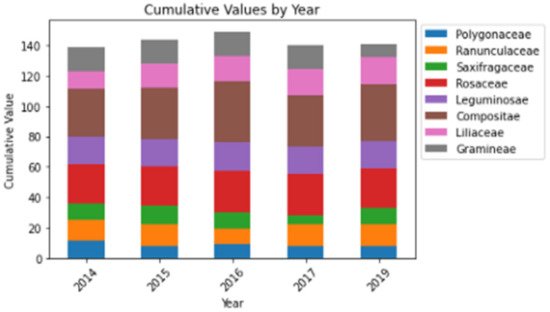
Figure 1. Number of taxa in each family present each year.
Table 1. Summary of plant taxa in the study sites by year.
| Year | Site | Family | Genus | Species | Forms | Subspecies | Varieties | Total |
|---|---|---|---|---|---|---|---|---|
| 2014 | Total | 92 | 257 | 311 | 8 | 3 | 44 | 366 |
| Grasslands | 60 | 212 | 266 | 6 | 2 | 36 | 310 | |
| Valley | 32 | 45 | 45 | 2 | 1 | 8 | 56 | |
| 2015 | Total | 92 | 254 | 309 | 6 | 3 | 42 | 360 |
| Grasslands | 60 | 210 | 264 | 4 | 2 | 35 | 305 | |
| Valley | 32 | 44 | 45 | 2 | 1 | 7 | 55 | |
| 2016 | Total | 93 | 257 | 312 | 7 | 3 | 44 | 366 |
| Grasslands | 62 | 213 | 268 | 5 | 2 | 36 | 311 | |
| Valley | 31 | 44 | 44 | 2 | 1 | 8 | 55 | |
| 2017 | Total | 89 | 243 | 288 | 7 | 3 | 44 | 342 |
| Grasslands | 58 | 199 | 245 | 5 | 2 | 36 | 288 | |
| Valley | 31 | 44 | 43 | 2 | 1 | 8 | 54 | |
| 2019 | Total | 89 | 249 | 300 | 7 | 3 | 47 | 357 |
| Grasslands | 58 | 205 | 257 | 5 | 2 | 39 | 303 | |
| Valley | 31 | 44 | 43 | 2 | 1 | 8 | 54 |
The plant species numbers according to Raunkiær’s life-form classification are shown in Figure 2. The numbers of each life form changed every year but had a different pattern. The numbers of two types, geophyte (G) and helophyte (H), fluctuated as a function of the event each year; they increased after thinning, decreased after grazing, and increased again when there was no feeding. The number of nanophanerophytes (N) decreased significantly after thinning and residue removal. However, it bounced back in 2016 even after grazing. In contrast, there were few changes in the numbers of microphanerophytes (M) and therophytes (Th).
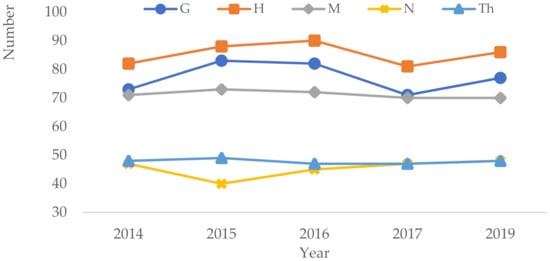
Figure 2. The plant species numbers according to Raunkiær’s life-form classification.
3. Changes in Plant Composition Due to the Forest Grazing Practices
The plant composition in the study area was analyzed according to the disturbances over time. It was highly affected by the disturbances and resulted in the disappearance of some rare plant species and an inrush of naturalized species (Table 2). First, 16 taxa disappeared after the thinning in 2015. Many shrubs (Rubus idaeus var. microphyllus, Rubus parvifolius f. concolor, Rubus phoenicolasius, Sorbaria sorbifolia var. stellipila, Sorbus commixta, Spiraea prunifolia f. simpliciflora, Spiraea salicifolia, and Stephanandra incisa) and herbaceous plants (Corydalis ochotensis, Sedum kamtschaticum, Sedum sarmentosum, Astilbe koreana, Astilbe rubra, Chrysosplenium grayanum, Sanguisorba officinalis, and Lamium album var. barbatum) disappeared because of residue removal from the forest floor. Meanwhile, nine plant species, including Populus tomentiglandulosa, Pennisetum alopecuroides, and Taraxacum officinale, newly emerged in 2015.
Table 2. Changes in floral composition in the study area by year and the disturbances. Underlined species disappeared once and revived 1 or 2 years later; bold species disappeared and never returned; bold and underlined species were newly observed and then disappeared 1 or 2 years later.
| Year (Disturbance) |
Appear | Disappear |
|---|---|---|
| 2015 (after thinning) | Populus tomentiglandulosa, Pseudostellaria heterophylla, Lamium amplexicaule, Meehania urticifolia, Cirsium japonicum var. maackii, Taraxacum officinale, Convallaria keiskei, Erythronium japonicum, Calamagrostis langsdorfii, (9) | Corydalis ochotensis, Sedum kamtschaticum, Sedum sarmentosum, Astilbe koreana, Astilbe rubra, Chrysosplenium grayanum, Rubus idaeus var. microphyllus, Rubus parvifolius f. concolor, Rubus phoenicolasius, Sanguisorba officinalis, Sorbaria sorbifolia var. stellipila, Sorbus commixta, Spiraea prunifolia f. simpliciflora, Spiraea salicifolia, Stephanandra incisa, Lamium album var. barbatum (16) |
| 2016 (1 month-grazing) | Morus bombycis var. maritima, Lepidium apetalum, Sedum kamtschaticum, Sedum sarmentosum, Astilbe koreana, Astilbe rubra, Chrysosplenium flagelliferum, Chrysosplenium grayanum, Rubus parvifolius, Rubus phoenicolasius, Sanguisorba officinalis, Sorbaria sorbifolia var. stellipila, Sorbus commixta, Spiraea prunifolia f. simpliciflora, Spiraea salicifolia, Ligusticum hultenii, Lamium album var. barbatum (17) | Morus bombycis, Anemone koraiensis, Hepatica asiatica, Viola diamantiaca, Peucedanum terebinthaceum, Chionanthus retusus, Lamium amplexicaule, Mosla punctulata, Scopolia japonica, Viburnum opulus var. calvescens, Erechtites hieracifolia, Streptopus ovalis (12) |
| 2017 (Grazing for 3 times and residue removal) | Hepatica asiatica, Corydalis ochotensis, Rubus idaeus var. microphyllus, Rubus oldhamii, Stephanandra incisa, Peucedanum terebinthaceum, Viburnum opulus var. calvescens, Erechtites hieracifolia (8) | Dennstaedtia wilfordii, Coniogramme intermedia, Asplenium ruprechtii, Thelypteris palustris, Onoclea orientalis, Lepisorus thunbergianus, Abies holophylla, Betula davurica, Carpinus laxiflora, Urtica angustifolia, Pseudostellaria heterophylla, Cimicifuga dahurica, Cimicifuga heracleifolia, Cimicifuga simplex, Corydalis pauciovulata, Draba nemorosa, Lepidium apetalum, Chrysosplenium flagelliferum, Euonymus sachalinensis, Viola verecunda, Ligusticum hultenii, Meehania urticifolia, Artemisia feddei, Cirsium japonicum var. maackii, Parasenecio auriculatus var. matsumuranus, Convallaria keiskei, Disporum viridescens, Erythronium japonicum, Calamagrostis langsdorfii, Symplocarpus renifolius, Oreorchis patens (31) |
| 2019 (no-grazing for 1~2 years) | Pseudostellaria heterophylla, Barbarea vulgaris, Thlaspi arvense, Isodon inflexus, Meehania urticifolia, Weigela florida, Artemisia montana, Artemisia stolonifera, Cirsium japonicum var. maackii, Convallaria keiskei, Erythronium japonicum, Paris verticillata, Smilax riparia var. ussuriensis, Calamagrostis langsdorfii, Carex humilis var. nana (15) | None |
In 2016, a year after thinning residual removal from the forest floor, 13 plant species among the 16 that disappeared in 2015 returned. Two plant species, Morus bombycis var. maritima and Rubus parvifolius, were observed for the first time from this area in 2016. Despite no residue removal from the floor, more plant species were lost in 2016. Twelve more species were lost in 2016 after a short period of livestock feeding in July.
There was a significant disappearance of plant species in 2017 due to three grazing events and additional forest floor removal. Thirty-one plant species disappeared, while 22 species did not return until 2019. Among these, two plant species (Rubus oldhamii and Erechtites hieracifolia) were not originally grown on the sites but emerged in 2016. Seven species were different from those in 2016, and they were revived ones that disappeared in 2015 and 2016. We did not notice any disappearance of plant species in 2019, which is the following year with no disturbances, i.e., thinning, residue removal, or grazing. On the other hand, 15 species appeared at this time. Six species, Pseudostellaria heterophylla, Meehania urticifolia, Cirsium japonicum var. maackii, Convallaria keiskei, Calamagrostis langsdorfii, and Erythronium japonicum, were revived ones that emerged in 2015 and then disappeared in 2017. The other nine species were newly observed in this area: Barbarea vulgaris, Thlaspi arvense, Isodon inflexus, Weigela florida, Artemisia montana, Artemisia stolonifera, Paris verticillata, Smilax riparia var. ussuriensis, and Carex humilis var. nana. When comparing the composition of plant species in 2019 and 2014, 16 species were not original components in the study area and were presumably introduced from outside the study site. Meanwhile, 31 plant species vanished from the original flora composition throughout the years.
4. Changes in Vegetation before and after Grassland Formation in the Forest
We analyzed the similarity of the sample quadrats and how they changed over the years using hierarchical cluster analysis, as shown in Figure 3. According to the analysis, there were no differences among the quadrats in 2014. However, they could be divided into three groups (red, green, and blue) in 2019 when the forest suffered many disturbances: thinning, residual removal, and grazing. Among 10 quadrats, eight were clustered in one group, and quadrats No. 3 and No. 10 were separated into different groups. The cluster in the red zone, quadrat No. 3, was occupied by Tripterygium regelii and Trifolium pretense. Quadrat No. 10 in the blue zone was dominated by some woody shrubs, Acer pseudosieboldianum and Stephanandra incisa. Quadrats in the green group had Carex callitrichos var. nana as a dominant species. It is thought that the topography differentiated the characteristics of the quadrats. Quadrat No. 3 was located at 900–920 m and had a gentle slope of 5–10°. The height of plants was about 0.5–1 m, and the coverage was 30–50%. There were only 11 species on average found in this quadrat, representing the fewest types of plants among the 10 quadrats. It is thought that the gentle slope led to it becoming a frequent grazing spot. In addition, the forest floor in this spot was severely damaged. Quadrat No. 10 in the blue zone was located at 910–930 m, similar to Quadrat No. 3, but the slope ranged from 10–15°, steeper than No. 3. The height of plants was about 1.5–3 m, and the coverage was 50–80%. On average, 58 species appeared in this quadrat. Various plants were observed along the dry valley, dominated by Acer pseudosieboldianum, Stephanandra incisa, Prunus sargentii, and Magnolia sieboldii, which are as tall as 2–8 m. This site was hard for cows to visit and feed, resulting in less disappearance of plant species due to grazing. The green cluster’s quadrats had a gentle slope and a suitable environment for cows to move around. Two plant species, Carex callitrichos var. nana and Festuca arundinacea in the Gramineae family, were most prevalent, and these are known ecosystem-disturbing plant species. Although these two species occurred in several quadrats in 2014, they dramatically expanded their coverage in 2019, replacing the habitats of the existing flora that disappeared throughout the years.
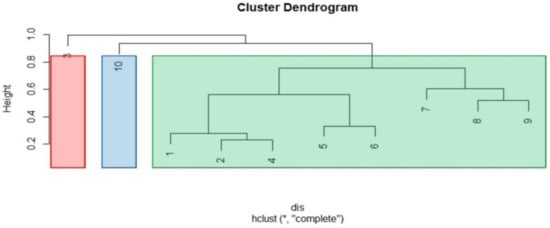
Figure 3. Cluster dendrogram applied to the “hclust” function in Vegan to perform hierarchical analysis with the cover degree of the plant. The “complete” option was used to express a compact cluster. The clusters in the red zone were areas occupied by Tripterygium regelii and Trifolium pratense. The clusters in the blue zone were areas dominated by Acer pseudosieboldianum and Stephanandra incisa. Green areas were inhabited by Carex callitrichos var. nana; 1–10 denote the site numbers.
The flora composition was characterized using stress plot analysis. According to the plant coverage of 10 quadrats, overlapped dots represent that the forest was covered with simple vegetation in 2014 (Figure 4a,b). On the other hand, the dots in 2019 were spread across various places, indicating that the major dominant species disappeared, and each quadrat was covered with different plant species (Figure 4c,d). Thus, it could be misread that the original flora composition was less diverse. However, there was a stable forest community with few dominant tree species and various herbaceous plants in the understory, including rare plant species. After human interruptions, the forest was covered with some heliophytes such as Sasa borealis, as well as plants on which cows did not feed.
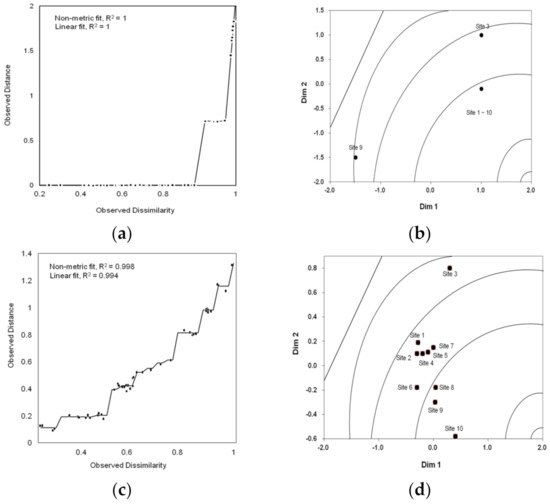
Figure 4. NMDS stress plot showing the location of the survey area that has changed since the formation of grasslands in forestry. In (a), as a result of ordination analysis, the stress plot in 2014 exhibits many overlapping lines and points. Applying this to forest vegetation reveals a simple forest vegetation structure in which a single plant type is distributed. (c) is the result of ordination analysis based on a plant survey in 2019. In 2019, a grassland was built in the research area and livestock was introduced. Hence, there were various factors that could disturb the understory vegetation. In 2019, the stress plot had points spread along the line. This indicates that the understory vegetation disturbances began as they formed grasslands in the forest. In (b,d), the location of the research plot was placed on the same contour line as the research area based on ordination analysis and the stress plot.
Detrended correspondence analysis showed that more plant species had broader coverage in the forest (Figure 5). Ten species had relatively higher coverage in 2014, and five of them, Symplocarpus renifolius, Isodon excisus, Symplocos chinensis f. pilosa, Sasa borealis, and Tripterygium regelii, had much higher ones. The number of species with high coverage was increased to 16 species, including existing species, Sasa borealis, Tripterygium regelii, and Aralia elata. Fourteen species became high-coverage plants, including Carex callitrichos var. nana, Festuca arundinacea, Rumex acetosa, and Lespedeza bicolor.
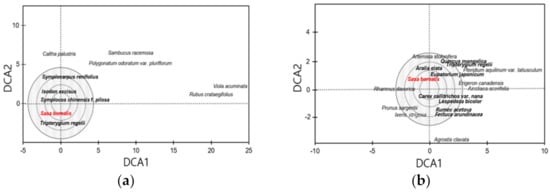
Figure 5. Detrended correspondence analysis (DCA). Plants that frequently appeared in the research area are shown on the graph, i.e., plants that appeared more frequently approach the center of the circle of the graph. (a) 2014; there were five species of plants that frequently appeared before grasslands were formed in the research area: Symplocarpus renifolius, Isodon excisus, Symplocos chinensis f. pilosa, Sasa borealis, and Tripterygium regelii. (b) 2019; the number of taxa increased compared to 2014 from 10 to 16, with five species increasing inside the target. The number of Sasa borealis increased, and the plants with increased cover were Aralia elata, Carex callitrichos var. nana, Eupatorium japonicum, Festuca arundinacea, Lespedeza bicolor, Quercus mongolica, Rumex acetosa, and Tripterygium regelii.
This entry is adapted from the peer-reviewed paper 10.3390/f12070872
References
- Yoo, B.I.; Seong, G.C. The Status and Development Directions of Agroforestry; Korea Forest Research Institute: Seoul, Korea, 2000.
- Seong, G.I.; Park, G.J. The Direction and Task of Revitalizing Forest Grassland as an Eco-Friendly Livestock in the 21st Century; The Korean Society of Grassland and Forage Science International Symposium: Seoul, Korea, 2002.
- Lautensach, H. The Korean Regions. In Korea; Dege, K., Dege, E., Eds.; Springer: Berlin/Heidelberg, Germany, 1988.
- Durst, P.B.; Waggener, T.R.; Enters, T.; Laycheng, T. Forests Out of Bounds: Impacts and Effectiveness of Logging Bans in Natural Forests in Asia-Pacific; FAO: Rome, Italy, 2001.
- Food and Agriculture Organization of the United Nations. Forest Management and Conservation Agriculture: Experiences of Smallholder Farmers in the Eastern Region of Paraguay; FAO: Rome, Italy, 2013.
- Kim, J.S. Agroforestry revitalization plan. Soc. For. Cult. 2000, 8, 32–40.
- Lee, K.J.; Jo, J.C.; Choi, Y.C. The community structure in old-growth forest of the Sangwonsa-Birobong area, Odaesan National Park. Korean J. Environ. Ecol. 1996, 9, 166–181.
- Noh, T.; Han, B.; Kim, J.; Lee, M.; Yoo, K. Actual vegetation and structure of plant community in Daegwallyeong ranch, Gangwon-do (Province). Korean J. Environ. Ecol. 2013, 27, 579–591.
- Kwon, K.W. The reality of Korea’s forest ecosystem and the eco-friendly coexistence of forest grasslands within the forest. Korean Soc. Grassl. Forage Sci. 2004, 34, 77–108.
- Finch, D.M. Assessment of Grassland Ecosystem Conditions in the Southwestern United States; Gen. Tech. Rep. RMRS-GTR-135-Vol. 1; US Department of Agriculture, Forest Service, Rocky Mountain Research Station: Fort Collins, CO, USA, 2004; Volume 1, 167p.
This entry is offline, you can click here to edit this entry!
